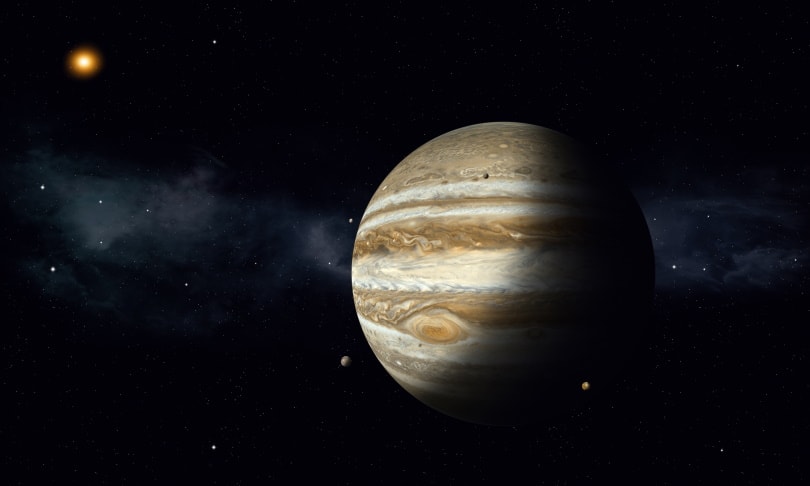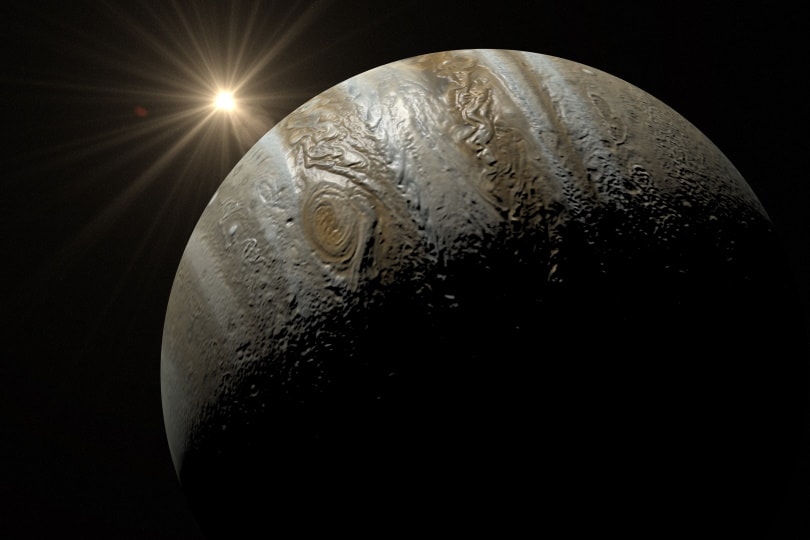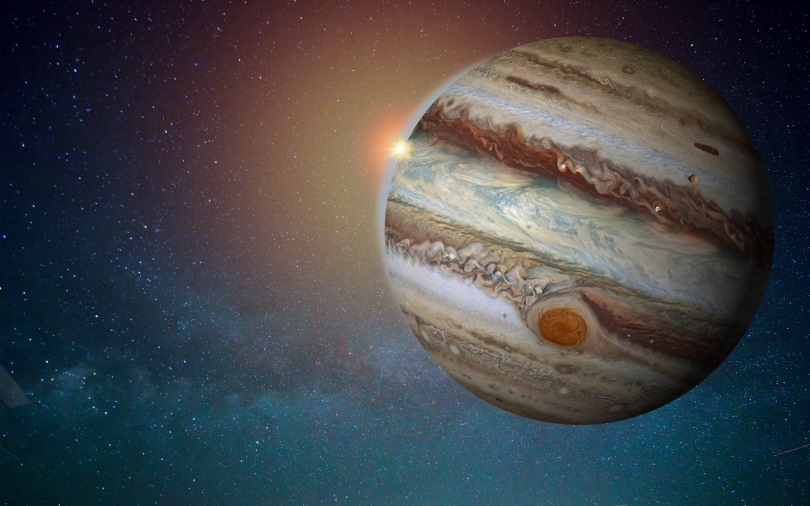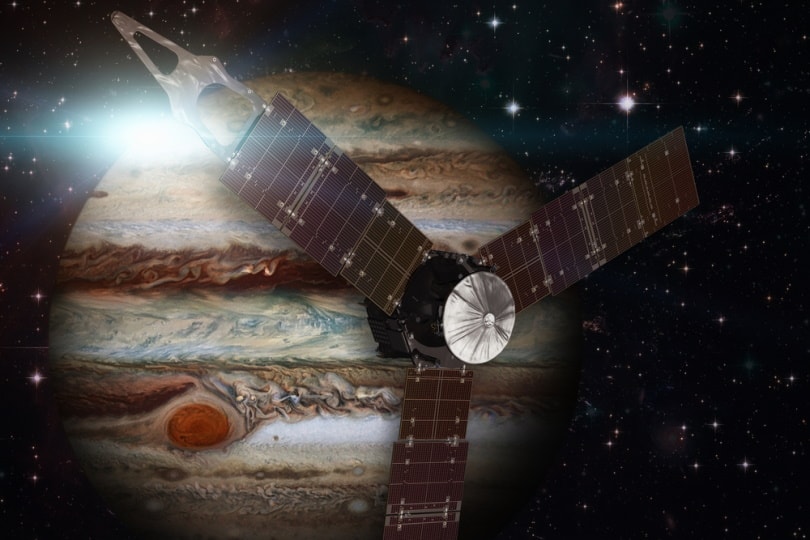How Hot Is Jupiter? Jupiter’s Atmosphere Explained
Last Updated on

There are 8 planets in our solar system. Planet nine is still considered a hypothetical planet, so it doesn’t count. Of the 8 planets, Jupiter is the largest. Most of it is in a gaseous state, but the core is solid and hot. Researchers at the National Aeronautics and Space Administration (NASA) discovered a while back that there’s a significant temperature gradient between that core and the planet’s surface. The average surface temperature is estimated to be minus 234 degrees Fahrenheit. Which translates to minus 145 degrees Celsius.
There are two things to take note of; one, even though we’re speculating that the temperature of its core keeps on fluctuating, that of its surface is relatively constant. In addition, it cannot support human life, as we would die of hypothermia!
Two, Jupiter doesn’t have a well-defined surface, seeing as it’s primarily gaseous. Therefore, our lead researchers had no other choice but to go with the assumption that the surface is an atmospheric layer with a pressure similar to that of our planet.

What is Jupiter’s core temperature?
From what we’ve gathered, Jupiter’s average core temperature at the moment is approximately 43,000 degrees Fahrenheit—an equivalent of around 24,000 degrees Celsius. To put that into context, Jupiter’s core temperature is higher than that of the sun’s surface, which is at 10,000 degrees Fahrenheit.
To be clear, we’re not referring to the sun’s core, but its surface. The core is 27 million degrees Fahrenheit.
Jupiter’s surface temperature doesn’t change the same way the Earth’s temperature does. There’s no fluctuation of shift the closer you move to the “equator,” because the heat is not influenced by the sun. Some degree of heat comes from the sun, but most of it originates from its interior. Any temperature variation is the product of changes in altitude. The farther away one moves from the surface, the cooler it becomes.

Is Jupiter a gas giant?
Jupiter is mostly hydrogen. Helium also contributes significantly to the overall plant’s composition, but 90% of Jupiter’s surface is hydrogen. Traces of other gasses have been detected over the years. And together, they all occupy the entire surface, all the way down to its core.
As mentioned earlier, what we’re referring to as the “surface” is the area of the planet where pressure is similar to ours. The connotation here is different from that which we’re used to, it’s not a solid surface. It’s purely made of gasses, so you could not stand on it even if you wanted to. Underneath that surface, all those gasses transform into liquid and plasma, which you’ll find as you move closer to the planet’s core.
The gasses constituting the surface are in several layers, and every layer has a different temperature. The bottom layer, the one closer to the core, has a temperature that’s lower than that of the liquid and plasma found directly below it. It keeps on decreasing as one ascends, ranging from -150F to -260F.
The next layer has a temperature that increases as you ascend. Thus, going back to its initial 150 degrees Fahrenheit. At the very top, you’ll find temperatures that are as high as 1,340 degrees Fahrenheit.

What’s the distance between Jupiter and the sun?
First off, you have to remember that Jupiter, like all the other planets, has its own elliptical path/orbit. This is the path followed by a planet as it revolves around the sun. The path is usually oval-shaped, meaning the distance from the planet to the sun will always vary. There will be times when the planet will be closer to the sun, and other times it will be farther away. The point is that it will never remain constant.
While studying astronomy, you’ll learn two words: Perihelion and Aphelion. The former refers to the point/time in orbit, when a planet or object is closer to the sun. While the latter is in reference to a point/time when the planet is most distant from the sun. Jupiter’s perihelion is about 460 million miles and its aphelion is 508 million miles. So on average, we’ll say the planet is roughly around 484 million miles from the star.

Is Jupiter’s center of mass closer to it or the sun?
In space, most objects orbit one another. And that system has something we like to call the “Center of Mass.” Sometimes referred to as the barycenter, it’s the point around which different planetary objects or bodies rotate, and is often found closer to the relatively bigger object. In the case of Jupiter and the Sun, it’s close to the sun because the sun is bigger in size.
Although scientists have concluded that all planets orbit the sun, if you think about it, you’ll realize both the star and the planets orbit the Center of Mass point. That’s to say, all planets have a Center of Mass with each other, in addition to the one shared with the sun. But seeing as the sun is larger than all of them, its barycenter will dominate the one found between, say Jupiter and Uranus.
Our solar system has a Center of Mass inside the sun. But since Jupiter is ridiculously large, the one it shares with the star is outside the sun’s diameter. As a matter of fact, it’s the only planet with a barycenter located outside the solar boundaries. Hypothetically, if you’re moving from the middle of the sun, you’ll find it at 1.07 solar radii.

What’s Jupiter’s “Great Red Spot?”
It looks like a spot, but in reality, it’s a gigantic storm. Experts say it’s about twice the size of our planet and circles Jupiter in the southern hemisphere. In the middle of it, there’s a relatively calm wind. However, as you move towards the edges, things start getting bumpy. We’re told the speed of wind in that area can get up to 425 miles per hour, which is more than the strongest hurricane we’ve ever experienced. To quench your curiosity, the most powerful hurricane falls under Category 5, with wind speeds of 156 miles per hour or more.
The Great Red Spot is a product of the swirling westward- and eastward-moving atmospheric stripes. They created it, and the reason why the storm has been active for more than a century. Somehow, the bands found a way to contain it, hence preventing the storm from exponentially growing to cover the whole planet.
The science community doesn’t really know why the storm is red but thinks that it could be the result of different chemical elements reacting. It’s either that or the end-product of lightning striking various molecules.
This storm has existed for that long, partly because Jupiter doesn’t have a solid surface. If it did, the same way Earth does, the storm would cease to exist after a while. Unfortunately, it doesn’t. And the “sky” is estimated to be 44 miles deep!

How big is Jupiter?
Our friends at NASA told us that the planet’s average radius is 43,440.7 miles. The sun’s radius is 432685.616 miles, making that of Jupiter one-tenth its radius. The sphere bulges at the equator because it’s rapidly rotating on its axis. It only takes 9.8 hours to complete a spin, and that’s why it looks like an oblate spheroid. Jupiter’s diameter at the poles is 83,082 miles, which is a couple of miles less than the equator’s 88,846-diameter.
Are there signs of potential life on Jupiter?
The conditions on Jupiter are too extreme for any form of life to survive. Experts aren’t totally sure if there are any, but judging from the materials, pressure, and temperatures that we’ve studied, it’s almost impossible to find any living organism on that planet.
But if you explore its moons, you’ll realize Europa—a name given to one of the moons—may be able to support life. The information that we’ve received confirms that there’s a vast water body underneath that icy crust. And where there’s water, there’s likely going to be life.

How many moons does Jupiter have?
Jupiter is like a star with its own planets revolving around it because it has a total of 53 confirmed moons. Four of them are extraordinarily large and were discovered in 1610 by Galileo Galilei. He was an astronomer who had a passion for science and loved to explore space using a telescope. The four are the Callisto, Ganymede, Europa, and Lo, and are referred to as the Galilean Satellites.
Callisto has tiny craters and doesn’t show any sign of life. Ganymede is known to be the largest moon in our solar system, with Lo being the predominantly active moon volcanically.

Conclusion
The average surface temperature on Jupiter is estimated to be minus 234 degrees Fahrenheit. Which translates to minus 145 degrees Celsius.
Jupiter has the least number of hours in a day. One spin equates to one day, which means if you spend 9.8 hours on that planet, you’ll have spent the whole day there. And to revolve around the sun, it takes 4,333 Earth days.
Featured Image Credit By alexaldo, Shutterstock
Table of Contents
About the Author Robert Sparks
Robert’s obsession with all things optical started early in life, when his optician father would bring home prototypes for Robert to play with. Nowadays, Robert is dedicated to helping others find the right optics for their needs. His hobbies include astronomy, astrophysics, and model building. Originally from Newark, NJ, he resides in Santa Fe, New Mexico, where the nighttime skies are filled with glittering stars.
Related Articles:
What Is the Best Binocular Magnification for Hunting? Optical Features Explained
How to Clean a Refractor Telescope: Step-by-Step Guide
How to Clean a Telescope Eyepiece: Step-by-Step Guide
How to Clean a Rifle Scope: 8 Expert Tips
Monocular vs Telescope: Differences Explained (With Pictures)
What Is a Monocular Used For? 8 Common Functions
How to Clean a Telescope Mirror: 8 Expert Tips
Brightfield vs Phase Contrast Microscopy: The Differences Explained
